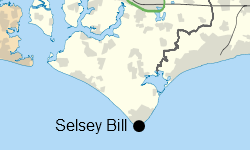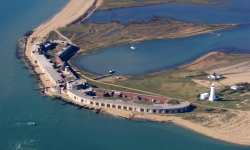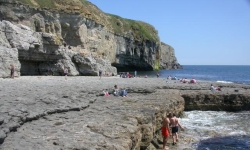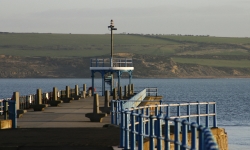
Brighton Marina – Great venue made up of East Arm and West Arm. A wide range of species can be caught here with the summer seeing great sport to anglers using light tackle. Float fishing a sprat, ragworm or mackerel strip bait on a size 1 – 1/0 hook will see mackerel, pollock, black bream and garfish caught, while spinners, daylights and feathers will also catch most of these species. A lugworm or ragworm bait fished on the seabed will see decent sized Dover sole and plaice caught, as well as other species such as silver eels, gurnard and dogfish. Anglers should vary casting distances and try fishing close in as good fish are caught very close to the structure of the marina. Stepping up the hook size to a 2/0 – 4/0 and using a large peeler crab, mackerel fillet or ragworm bait can catch good bass. Winter sees decent catches of cod, whiting, flounder and rockling. A pennell rig with 4/0 hooks or bigger, baited with a full squid, black lugworm or frozen peeler crab will potentially catch a big cod, while 1/0 hooks baited with mackerel strip or ragworm/lugworm will catch the rockling, flounder and whiting. It is also possible to catch squid from this mark using a rod and line – see this page for more information on this fishing technique. The ground around the marina is mixed with some snaggy patches. Anglers must buy a ticket to fish from the marina and this area will be busy with tourists in summer. View this area on Google Maps here.

Southwick, Worthing Pier and Littlehampton – Southwick beach can be good for bass when the sea is running. Other species such as silver eels, dogfish and various flatfish also caught here, as well as the chance of a smooth-hound to crab crab baits fished at distance. Worthing pier can provide great sport with many species such as black bream, mackerel, garfish, wrasse, bass and dogfish caught all summer. Winter sees cod, whiting, rockling and flounder caught. Two or three hours either side of high tide is the best time to fish the pier. Fishing is restricted from certain sections of the pier and the pier is closed at night and during periods of bad weather. Littlehampton has Climping Beach and the beach at East Preston. Both can fish well for whiting and cod over winter, while other times of the year can see sole, dogfish and big bass turn up. There is also the chance of a thornback ray or stingray from these marks in summer. Mullet can be caught from Littlehampton harbour and along the River Arun. View this area on Google Maps here.

Bognor Regis – The beaches here can produce decent fish with dogfish, pouting and Dover sole providing good catches and the chances of something more desirable such as a large bass (when the surf is running) thornback ray or smooth-hound in calmer seas. Two hook rigs with size 4 – 6 hooks baited with ragworm will catch the sole, while stepping the hooks up to size 1/0 is better for the dogfish and pouting. Peeler crab will catch the smooth-hound, whereas mackerel fillets or sandeel fished at range will provide the best chances of hooking a ray. The pier at Bognor Regis can also produce a wide range of species such as mackerel, bass, black bream, pouting and Dover sole, as well as whiting and cod in the winter months. Two hours either side of high tide is the best time to fish this venue. View this area on Google Maps here.

Selsey Bill and Selsey Beaches – Selsey Bill is a headland jutting out into the English Channel which can produce great fishing. Bass can be caught on spinners and plugs and baits presented on the seabed can potentially produce bass in the summer and good cod in the winter. However, tidal flow can be fierce, to the point that keeping a bait on the seabed is difficult or even impossible. Selsey East and West beaches are either side of Selsey Bill. In the summer large smooth-hound are a real possibility to peeler crab and hardback crab baits. Bass can also be caught by casting peeler crab or ragworm baits cast just behind the breakers. Dover sole can be caught to worm baits mounted to small hooks fished on the bottom and dogfish, flounder and pouting can be caught most of the year round. Whiting and big cod turn up in the winter to the usual lugworm, frozen peeler crab, mussel and squid baits. Certain areas of these beaches can be snaggy and masses of weed can present a problem in certain conditions. View this area on Google Maps here.

Bracklesham Bay, East and West Wittering Beach – Bracklesham Bay can produce bass to ragworm and peeler crab baits. Pouting, dogfish, flounder and Dover sole are all possible catches as well. There is the chance of a smooth-hound in the summer months to hardback or peeler baits and thornback ray can be caught to mackerel or herring fillet or sandeel fished at range. Similar species can be caught further along the beach at East Wittering and West Wittering, although weed can reach fishing-stopping proportions in the wrong conditions. View this area on Google Maps here.

Portsmouth and Southampton Marks – Langsdown Harbour is a good high tide venue. It can hold school bass and some much larger specimens. The larger bass can be caught on mackerel fillet, ragworm or large squid or peeler crab baits. This harbour is also a flounder hotspot with ragworm and lugworm baits on size 1 – 1/0 hooks on multi-hook rigs the best method of catching them. Victoria Pier offers mackerel and garfish to float fished baits and spinners in the summer, with mullet also a possibility in calm summer weather. Eastney beach is a steeply sloping shingle beach which can produce a range of species. Plaice, gurnard, red mullet and black bream can be caught in the warmer months with whiting, cod and pouting caught in the winter. Anglers here should try varying casting ranges as bass and flounder can be taken close in, but sometimes casts may have to be at longer distances to put a bait amongst the feeding fish. Mayflower Park in Southampton can produce mullet to bread, earthworm, fish flake or maggot baits. Plenty of other species can be caught here with conventional bottom fishing. Try a two hook flapping rig with size 1/0 hooks and flounder, whiting, school bass and pouting could all be caught. View this area on Google Maps here.

Hillhead, Hampshire – Hill Head beaches/spit can be fished at low tide, while Hill Head Sea Wall is a comfortable and accessible platform to fish from at high tide. This area is seen as a hotspot for smooth-hounds in the spring and early summer with some justification – the British record smooth-hound of 20lb 3oz was caught from the sea wall in 2000. Crab are the best bait to catch the smooth-hound with peeler and hardbacks both catch and some anglers making a cocktail bait of half peeler and half hardback. A number of different species of ray (including stingrays) can also be caught here, with sandeels the best bait to catch this species. The popularltity of these marks mean they can get very busy with anglers, especially when the smooth-hound are around and on weekends and public holidays. Other species which can be caught from this area on general rigs (i.e. one or two hook rigs with size 1/0 or 2/0 hooks and ragworm, lugworm, mackerel strip baits etc) include whiting, codling, flounder and plaice. View this mark on Google Maps here.

Isle of Wight – Ventnor Bay in the south of the island can produce bass from the beach and mullet are also found in this area when the sea is calm. Ryde Pier is a great mark for light summer fishing. Pollock, mackerel and garfish will go for spinners and floatfished baits, while black bream, wrasse, bass and silver eel will also be taken and there is always the chance of a summer smooth-hound on peeler crab or hardbacks. There is a small charge for fishing from the pier and some restrictions on when and where fishing can take place. Rocky marks around Bembridge Harbour (and any other rocky marks around the island) can hold decent sized conger to anglers using size 4/0 – 6/0 hooks and large mackerel fillet or herring as bait. Bembridge Harbour will also produce wrasse, bass and pollock, while Cowes Harbour is good for mullet in calm weather. View this area on Google Maps here.

Milford Shingle Bank and Hurst Castle – This area can produce smooth-hound, dogfish, pouting, brill and black bream in the summer and cod and whiting in the winter. Hurst Castle is a venue that allows short to medium range casts to find deep water. This means that in the winter good cod are within range with large 4/0 – 6/0 hooks on a pennel baited with a whole squid or large black lugworm being in with the chance of catching a big fish. Other times of the year can see good wrasse and pollock from the rocky areas, and there is also large bass around here. However, be aware that in big tides and certain conditions the tidal flow can be very strong indeed and fishing is often very difficult or at times impossible. View this area on Google Maps here.

Christchurch Harbour – The Christchurch area offers some great fishing venues for the sea angler. Christchurch Harbour is a unique natural harbour which, due to the unusual and unique tidal characteristics of the English Channel, means that this area has double high tides. Outside of the harbour the clean, sandy Avon beach fishes well for bass in summer, with Dover sole, dogfish, pouting and silver eels going for the usual baits. Thornback ray are also a possibility. Avon beach is generally seen as fishing better in summer but some cod, whiting and flounder can be about in winter. /Mudeford Quay can fish well for bass in the summer to ragworm, sandeel, peeler crab or mackerel baits. Fishing here is quieter in winter but (small) whiting and cod can be about. All of the harbour area fishes very well for mullet, a fact underlined by the UK record for golden grey mullet coming from this area. However, the usual small hooks, stealthy tactics and groundbaiting methods are needed to catch these species. View this area on Google Maps here.

Bournemouth and Poole – Bournemouth Pier is a good high tide mark which can produce Dover sole, wrasse, pouting and dogfish, as well as the chance of something bigger such as a ray or smooth-hound. Mackerel will also be caught to spinners and lures in the summer. This mark will be packed with tourists, surfers and other water-based events in the summer and pier is locked overnight. Winter will see flounder, rocking and whiting caught. Poole Harbour has a number of locations where school bass can be caught to baits or spinners. It is also something of a flounder hotspot – use size 1 long-shanked hooks and worm baits to target this species. Silver eels will also be caught here with peeler crab the top bait for them. Poole Harbour is a nursery area for bass – shore fishing is still permitted but fish should be returned. Nearby Studland Bay has can produce decent catches of flounder as well as school bass to peeler crab, mackerel strip and ragworm. View this area on Google Maps here.

Swanage Pier and Peveril Point – Swanage Pier is a good venue for summer fishing. Float fishing can produce garfish and wrasse as well, set baits close to the surface for garfish and deeper for other species. Bass and larger pollock will be caught on spinners as will the usual mackerel. Bottom fished baits will produce a range of species from bass and plaice to rockling, dogfish and pouting. The pier is only open during certain times so check these prior to travelling and the area can get very busy in the summer months. The nearby Peveril Point can be a good alternative option when the pier is too busy or closed. This is a rock mark that can be fished with spinners, lures or float fished baits for very good bass and wrasse. Mackerel can also be caught on spinners, feathers and daylights. Various different species can be caught by fishing baits on the seabed, including potentially large conger eels, but be aware that this area is very snaggy indeed and large tackle losses will have to be tolerated. View this area on Google Maps here.

Dancing Ledge, Dorset – This is a good mark that lends itself to light gear – bass or spinning rods – and float fishing or spinning. Spinners will produce some mackerel and garfish over the summer with decent pollock also providing sport. Float fished mackerel strip or ragworm will also catch wrasse which are plentiful around here. There is a steep descent to this mark and a long walk so be aware of this before setting off. Bass also caught from around here and reports of rays, but the seabed is extremely snaggy indeed so many anglers stick to spinning or float fishing to avoid the tackle losses which will be inevitable if presenting baits on the seabed. Once the sun begins to set a strong 6/0 – 8/0 baited with a mackerel flapper or squid/cuttlefish could tempt a decent sized conger eel, but the unforgiving snags of the seabed need to be taken into account so strong beachcasters and multipliers should be used if this species is targeted, and rotten bottoms incorporated into rigs. View this area on Google Maps here.

St Alban’s Head – St Alban’s Head is a rocky headland approximately three miles southwest of Swanage. Access to fishable marks can be difficult here with a little climbing and scrambling over rocks necessary, and anglers must take care – especially in wet and slippery conditions. It is best to fish this mark with someone with local knowledge and only attempt to fish here in calm and settled weather in order to stay safe. Using spinners and plugs for bass and pollock can be very productive here, and some very good wrasse take float fished worm and mackerel baits. Dogfish, bull huss and a variety of different rays will also take bottom fished baits, as will large conger eels. However, the ground here is very snaggy indeed so suitable tackle and rigs with rotten bottoms are needed. Some anglers prefer to stick to float and lure fishing here in order to avoid the snaggy seabed. View this area on Google Maps here.

Weymouth Stone Pier – Casting into the harbour side of the pier is cleaner and has fewer snags, while the seaward side is slightly rougher ground. Mackerel and garfish can be caught in the summer to spinners and lures, and will also take float fished baits, as will wrasse, pollock and some bream species. Sprats, mackerel strip, ragworm and small sandeels are the best baits to use with a float. Bass can be caught from here to bottom fished ragworm and peeler crab, as will silver eels. Dogfish are also caught and will take most baits, although mackerel strip is probably the best choice to specifically target them. Ringstead Bay a few miles to the east is another great mark. From the rockier section here conger can be caught to mackerel fillet, mackerel head, whole herring or squid mounted on big hooks, while wrasse and pollock are also found around the rocks. Decent sized bass can be caught here to peeler crab, sandeel, ragworm or mackerel baits cast just behind the breakers, while general fishing on a two hook flapping rig with size 1/0 hooks will catch dogfish, pouting and flounder. Bull huss are also a possible catch here. A number of different ray species are also caught here to sandeel baits fished at range. The area can be very busy in the summer months so early morning or night are the best times to go fishing. View this area on Google Maps here.

Portland Bill – Portland Bill is a rocky headland that makes up the most southerly point of Dorset. It is made up of extremely rocky and snaggy ground that provides some excellent fishing. Pulpit Rock is a popular fishing mark towards the end of the headland, and there are also rock ledges that are also good fishing marks. Very good wrasse can be caught from these areas to worm and crab baits (try presenting a float fished bait down the rock ledges) as well as bass and pollock to baits and spinners and other species such as a bream and garfish. Large conger eels can also be found in the rocks and heavy fishing gear and mackerel flappers, herring or squid could tempt a large specimen. The British record shore caught wrasse of 9lb 1oz in was caught here in 1998. The tidal flow can also be strong and make fishing difficult in certain conditions, and many fishing marks can involve having to haul fish a long way up from the sea so anglers should think about how large fish will be landed (and ensure it is safe to do so). Be aware that the nature of this mark means that access can be difficult and that bad weather and rough seas make this mark too dangerous to fish. View this area on Google Maps here.

Chesil Beach – A very famous angling venue, Chesil Beach is an eighteen-mile long strip of land (known as a tombolo or barrier beach) with water either side of it. It is made of steeply sloping shingle so that fairly short casts can place a bait into deep water. The Abbotsbury side of the beach is very popular in summer with mackerel anglers and can get very busy, but at quieter times fishing from this point can be excellent. A huge range of species can be caught here. Cod and big whiting are caught in the winter, along with flounder. Summer sees smooth-hound, thornback rays, Dover sole and gurnards. Pouting and dogfish can be caught all year round and other species which can be caught here include trigger fish, turbot, brill, scad, dab and bull huss. The area around the Dragon’s Teeth (anti-tank defences left over from the Second World War) are a top winter cod mark. Chesil Cove, on the other side of the beach is rockier and offers pollock to float fished baits and potentially conger eels to mackerel fillet, whole herring or squid. Certain parts of Chesil Beach are protected and cannot be fished from. View this area on Google Maps here.

Budleigh Salterton and Exmouth – The shingle beach at Budleigh Salterton offers a number of species. Dogfish can be caught to most baits on size 1 – 1/0 hooks with occasional bull huss turning up as well. Dover sole can be caught to ragworm and lugworm baits fished on small size 4 – 6 hooks and pouting are also around in numbers. The rockier marks towards the east of the beach can produce wrasse and pollock to float fished baits, and potentially conger eels to the mackerel, herring or squid baits presented on large hooks and wire traces. Mackerel can be caught along the length of the beach to feathers and daylights, although it can get very busy. Similarly, tourists can be a problem when trying to fish during peak season. The estuary of the River Otter also holds mullet which can be caught to stealthy tactics and bread, earthworm, fish flake or maggot baits. Exmouth Harbour also holds mullet, as well as mackerel and garfish to spinners and daylights. Pollock will also take lures and spinners from here, as well as float fished baits – try mackerel strip, sandeel or sprat. Silver eels can also be caught to bottom fished peeler crab, mackerel or worm baits. The nearby sandy beach can produce good catches of plaice and Dover sole, as well as bass when the sea is running. View this area on Google Maps here.

Teignmouth – The mouth of the River Teign is known to produce good bass catches to sandeel, peeler crab and ragworm baits. It is a bass nursery area but bass can still be legally caught from the shore. Anglers, however, return all bass in order to protect numbers and allow the nursery area to maintain stocks. Mackerel, scad and garfish can all also be caught here on spinners, daylights and feathers, as well as on float fished baits. Mullet are also a possibility here when the weather is calm. Very good flounder fishing can be had here with specimen sized fish caught. The flounder will go for ragworm and lugworm baits but peeler crab is the top bait for this species here. Good flounder and bass catches can be taken surprisingly far inland up the river. View this area on Google Maps here.
